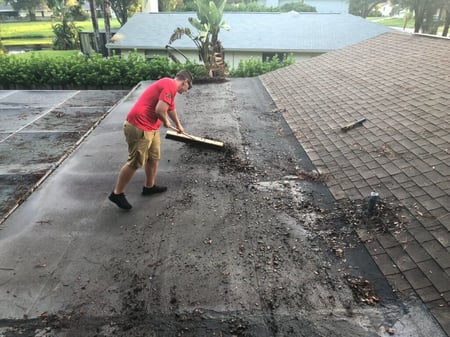The Ultimate Spring Roofing Maintenance Checklist
April , 2025 | 6 min. read

Spring has sprung, and so has the need for roof maintenance. After months of heavy winds, rain, and maybe even snow, your roof has been doing the hard work of protecting your home. But now that the weather is warming up, it’s the perfect time to give it the TLC it deserves.
At RoofCrafters, we know all too well how unpredictable southeastern winters can be, and then, of course, there’s hurricane season. Spring is the perfect time for home improvement projects due to its generally milder weather. Knock on wood!
So, whether you’re a new homeowner or a seasoned pro at spring cleaning, having a clear, actionable spring roofing maintenance checklist will save you from costly surprises down the road. Let’s dive into everything you need to do this season to keep your roof in top shape!
Why Spring Is the Ideal Time for Roof Maintenance

Before we get into the checklist, let’s talk about why spring is the best season for roof inspections and maintenance.
- Winter damage becomes visible. Snow, ice, and freezing temperatures can wreak havoc on shingles, flashing, and gutters. Spring gives you a chance to spot what winter may have broken.
- Better weather = safer inspections. Dry, mild temperatures make it safer for roofers (or ambitious DIYers) to assess and address roofing issues.
- Prevent summer storm damage. In many regions, summer storms are no joke. Catching issues early helps prevent leaks and structural problems when the next storm rolls in.
Spring Roofing Maintenance Checklist for Homeowners

The first step in spring roofing maintenance is giving your roof a good once-over. From the ground, grab a pair of binoculars or use your phone’s zoom to look for:
- Missing or damaged shingles
- Cracked, curling, or blistering shingles
- Dark spots or signs of algae/moss growth
- Sagging areas or uneven sections
If you’re comfortable getting on the roof, take extra caution and wear proper footwear. Not into heights? No shame. Call a professional roofing contractor for a full roof inspection!
Clear Debris Off the Roof
Twigs, branches, leaves, and even rogue frisbees can build up over the winter. This debris traps moisture and can lead to mold, mildew, or rot, especially in valleys where water naturally flows. Use a soft broom or leaf blower to gently clear the roof. Avoid pressure washing, which can damage shingles.
Check and Clean Gutters and Downspouts
Clogged gutters are one of the leading causes of roof leaks and water damage. Overflowing water can back up under the roofline or pool near your home’s foundation.
Here’s your spring gutter checklist:
- Remove leaves, twigs, and gunk from gutters
- Flush downspouts with a hose
- Check for rust, sagging, or separation from the house
- Ensure water flows away from the foundation
Inspect Flashing and Sealants
Flashing is the metal strip that seals joints around chimneys, vents, and skylights. Over time, flashing can crack, warp, or pull away from the roof, especially after freeze-thaw cycles.
Look for:
- Loose or lifted flashing
- Cracked or dried-out sealant
- Rust or corrosion
Resealing these areas is a simple fix that can prevent massive headaches, especially during spring showers.
Look in the Attic
If your attic is accessible, now’s the time to do a quick interior roof inspection. Check for:
- Signs of water intrusion (wet spots, stains, or mold on rafters)
- Sunlight shining through (a clear sign of holes or gaps)
- Musty smells that could indicate moisture buildup
- Adequate ventilation
Good attic ventilation helps prevent heat and moisture buildup that can damage your roof from the inside out. Spring is a great time to upgrade vents or add insulation if needed.
Trim Overhanging Branches
Trees are great for shade, but if branches are hanging too close to your roof, they can scrape against shingles or drop debris during storms. Trim branches back at least 6 to 10 feet from the roofline to:
- Prevent physical damage to shingles
- Minimize leaf and twig buildup
- Deter animals from accessing your roof (yes, even squirrels can cause roof damage)
Bonus points if you also check for dead limbs that could break off during high winds.
Examine the Chimney and Skylights
Don’t forget your chimney and skylights; these are often leak-prone areas.
- Inspect chimney mortar and bricks for cracks
- Look for signs of rust or loose metal flashing around skylights
- Check for cloudy or foggy skylight glass, which could signal a broken seal
These areas might require a professional roofing contractor to repair, but early detection is key.
Schedule a Professional Roof Inspection (If Needed)
Not every roofing problem is obvious. Even if your DIY check doesn’t raise red flags, hiring a roofing professional for a spring inspection can give you peace of mind. Many companies offer free or low-cost roof inspections, especially during the spring maintenance season. A pro will assess:
- Shingle condition
- Flashing and sealant integrity
- Ventilation and attic health
- Hidden leaks or moisture intrusion
Plus, they’ll give you an estimate if any repairs are needed, letting you budget and prioritize early.
Review Roof Warranty and Insurance Coverage
While this isn’t a physical inspection item, spring is a good time to pull out your roof warranty and homeowners insurance policy. Know what’s covered (and what’s not) in the event of:
- Storm damage
- Hail or wind impact
- Water intrusion
It’s also worth taking photos of your roof in good condition, so if you need to file a claim later, you’ve got documentation to back you up.
Protect Your Home with Spring Roof Maintenance

Spring cleaning isn’t just for closets and garages; it’s essential for your roof, too. This spring roofing maintenance checklist for homeowners gives you a practical, proactive way to protect your investment, boost curb appeal, and avoid surprise repairs later on.
Here’s a quick recap of your to-do list:
- Inspect the roof surface
- Remove roof debris
- Clean gutters and downspouts
- Check flashing and sealants
- Look in the attic
- Trim tree branches
- Inspect chimneys and skylights
- Schedule a pro inspection (if needed)
- Review warranties and insurance
By following these spring maintenance steps, you’re setting your home up for a successful (and dry) season ahead. If you’d rather leave it to the experts, we’re here to help. Our team offers thorough spring roof inspections, minor repairs, and full maintenance packages to keep your home safe and sound. Contact us today to schedule your inspection and get your roof ready for summer!
My name is Cassie, and I’m the Content Manager here at RoofCrafters. I was born and raised in Chicago, Illinois, and made my way out to Florida post-college graduation. I’m incredibly passionate about writing and creating valuable content that helps others with the collaboration of my marketing team. When I’m not working, I enjoy shopping (a little too much), spending time at the beach, and reading!




